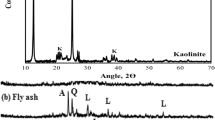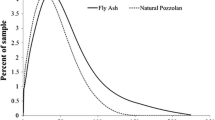Abstract
The use of porous particles as aggregates in cementitious mixes presents advantages such as reducing dead load and assisting in thermal insulation of constructions. Pumice aggregates are most commonly used because they are cheap, natural and easily obtainable. However, there are also disadvantages such as brittle behavior and decrease in strength. In this study, 0, 1 and 2 vol% polypropylene fibers (PF) having 40 micrometer diameter were used in the production of mortars containing acidic (AP) and basaltic pumices (BP) in place of calcareous sand (CS), in order to overcome these challenges. In addition to mechanical properties (compressive, flexural and splitting tensile strength), physical properties (bulk density and capillarity) and morphology of mortars (scanning electron and optical microscopy) were also investigated. The results showed that bulk density of BP mortars was about 10% lower and that of AP mortars was about 15% lower than that of CS mortars. Flexural strength of BP and CS mortars were over 7 MPa, whereas that of AP mortars were in 4–6 MPa range. Addition of 1% PF improved the mechanical properties, whereas addition of 2% PF resulted in a decrease in strength in all mortar types. The highest 1-year compressive strength was obtained by the BP sample having 1% PP fiber. Furthermore, there was a strong relationship between the strength and bulk density of mortars.











Similar content being viewed by others
References
Priyadharshini, P.,;Ganesh, G.M.; Santhi, A.S.: A review on artificial aggregates. Int. J. Earth Sci. Eng. 5, 540–546 (2012)
Kockal, N.U.; Ozturan, T.: Durability of lightweight concretes with lightweight fly ash aggregates. Constr. Build. Mater. 25, 1430–1438 (2011)
Kockal, N.U.; Ozturan, T.: Characteristics of lightweight fly ash aggregates produced with different binders and heat treatments. Cem. Concr. Compos. 33, 61–67 (2011)
Kockal, N.U.; Ozturan, T.: Optimization of properties of fly ash aggregates for high-strength lightweight concrete production. Mater. Des. 32, 3586–3593 (2011)
Gonen, T.; Yazicioglu, S.: The effect of curing conditions on permeation of self-compacting lightweight concrete with basaltic pumice aggregate. Arab. J. Sci. Eng. 43, 5157–5164 (2018)
Karahan, O.; Khandaker, M.A.H.; Atis, C.D.; Lachemi, M.; Ozbay, E.: Ground granulated pumice-based cement mortars exposed to abrasion and fire. Arab. J. Sci. Eng. 42, 1321–1326 (2017)
Hossain, K.M.A.; Ahmed, S.; Lachemi, M.: Lightweight concrete incorporating pumice based blended cement and aggregate: mechanical and durability characteristics. Constr. Build. Mater. 25, 1186–1195 (2011)
Onoue, K.; Tamai, H.; Suseno, H.: Shock-absorbing capability of lightweight concrete utilizing volcanic pumice aggregate. Constr. Build. Mater. 83, 261–274 (2015)
Crangle, R.D.: Pumice and pumicite. In: Salazar, K., McNutt, M.K. (eds.) US geological survey minerals yearbook, pp. 124–125. United States Government Printing Office, Washington (2010)
Hossain, K.M.A.: Properties of volcanic pumice based cement and lightweight concrete. Cem. Concr. Res. 34, 283–291 (2004)
Jitha, M.V.: Experimental investigation of mortar cube with pumice powder and ceramic tile powder. Int.J. Adv. Res. Ideas Innov. Technol. 3, 815–821 (2017)
Kockal, N.U.: Investigation about the effect of different fine aggregates on physical, mechanical and thermal properties of mortars. Constr. Build. Mater. 124, 816–825 (2016)
Parto, P.; Kalantari, B.: Influence of polypropylene fibers on the compressive strength of windblown sand-cement mortar. Electron. J. Geotech. Eng. 17, 225–240 (2012)
Santos, A.G.; Rincón, J.M.; Romero Talero, M.R.: Characterization of a polypropylene fibered cement composite using ESEM, FESEM and mechanical testing. Constr. Build. Mater. 19, 396–403 (2005)
Song, P.S.; Hwang, S.; Sheu, B.C.: Strength properties of nylon-and polypropylene fiber-reinforced concretes. Cem. Concr. Res. 35, 1546–1550 (2005)
Tang, V.L.; Vu, K.D.: Mechanical properties of building mortar containing pumice and coconut-fiber. In: Murgul, V., Pasetti, M. (eds.) EMMFT 2018, AISC 982, pp. 648–659. Springer Nature, Basel (2018)
Benyahia, A.; Ghrici, M.; Choucha, S.; Omran, A.: Characterization of fiber reinforced self-consolidating mortars for use in patching damaged concrete. Lat. Am. J. Solid Str. 14, 1124–1142 (2017)
Izaguirre, A.; Lanas, J.; Alvarez, J.I.: Effect of a polypropylene fibre on the behaviour of aerial lime-based mortars. Constr. Build. Mater. 25, 992–1000 (2011)
Feng, H.; Gao, D.; Yuan, J.: The mechanical properties of polypropylene fiber reinforced polymer modified cement mortar. Appl. Mech. Mater. 438–439, 283–289 (2013)
Low, I.M.: Ceramic-matrix composites, microstructure, properties and applications. Woodhead Publishing Limited and CRC Press LLC, Cambridge (2006)
Lim, N.H.A.S.; Sam, A.R.M.; Samadi, M.; Mohammadhosseini, H.: Effects of elevated temperatures on residual properties of concrete reinforced with waste polypropylene carpet fibres. Arab. J. Sci. Eng. 43, 1673–1686 (2018)
Bogas, J.A.; Gomes, T.: Mechanical and durability behaviour of structural lightweight concrete produced with volcanic scoria. Arab. J. Sci. Eng. 40, 705–717 (2015)
Kılıç, A.; Sertabipoğlu, Z.: Effect of heat treatment on pozzolanic activity of volcanic pumice used as cementitious material. Cem. Concr. Compos. 57, 128–132 (2015)
Samimi, K.; Kamali-Bernard, S.; Maghsoudi, A.A.; Maghsoudi, M.; Siad, H.: Influence of pumice and zeolite on compressive strength, transport properties and resistance to chloride penetration of high strength self-compacting concretes. Constr. Build. Mater. 151, 292–311 (2017)
Kockal, N.U.: Behavior of mortars produced with construction wastes exposed to different treatments. Indian J. Eng. Mater. Sci. 22, 203–2014 (2015)
Degirmenci, H.; Yılmaz, A.: Use of pumice fine aggregate as an alternative to standard sand in production of lightweight cement mortar. Indian J. Eng. Mater. Sci. 18, 61–68 (2011)
Libre, N.A.; Shekarchi, M.; Mahoutian, M.; Soroushian, P.: Mechanical properties of hybrid fiber reinforced lightweight aggregate concrete made with natural pumice. Constr. Build. Mater. 25, 2458–2464 (2011)
Li, J.; Niu, J.; Wan, C.; Liu, X.; Jin, Z.: Comparison of flexural property between high performance polypropylene fiber reinforced lightweight aggregate concrete and steel fiber reinforced lightweight aggregate concrete. Constr. Build. Mater. 157, 729–736 (2017)
Acknowledgements
Authors are grateful to Akdeniz University Scientific Projects Coordination Unit for their support.
Author information
Authors and Affiliations
Corresponding author
Rights and permissions
About this article
Cite this article
Kockal, N.U., Camurlu, H.E. Lightweight Pumice Mortars with Polypropylene Fiber Reinforcement. Arab J Sci Eng 45, 8087–8097 (2020). https://doi.org/10.1007/s13369-020-04617-0
Received:
Accepted:
Published:
Issue Date:
DOI: https://doi.org/10.1007/s13369-020-04617-0




